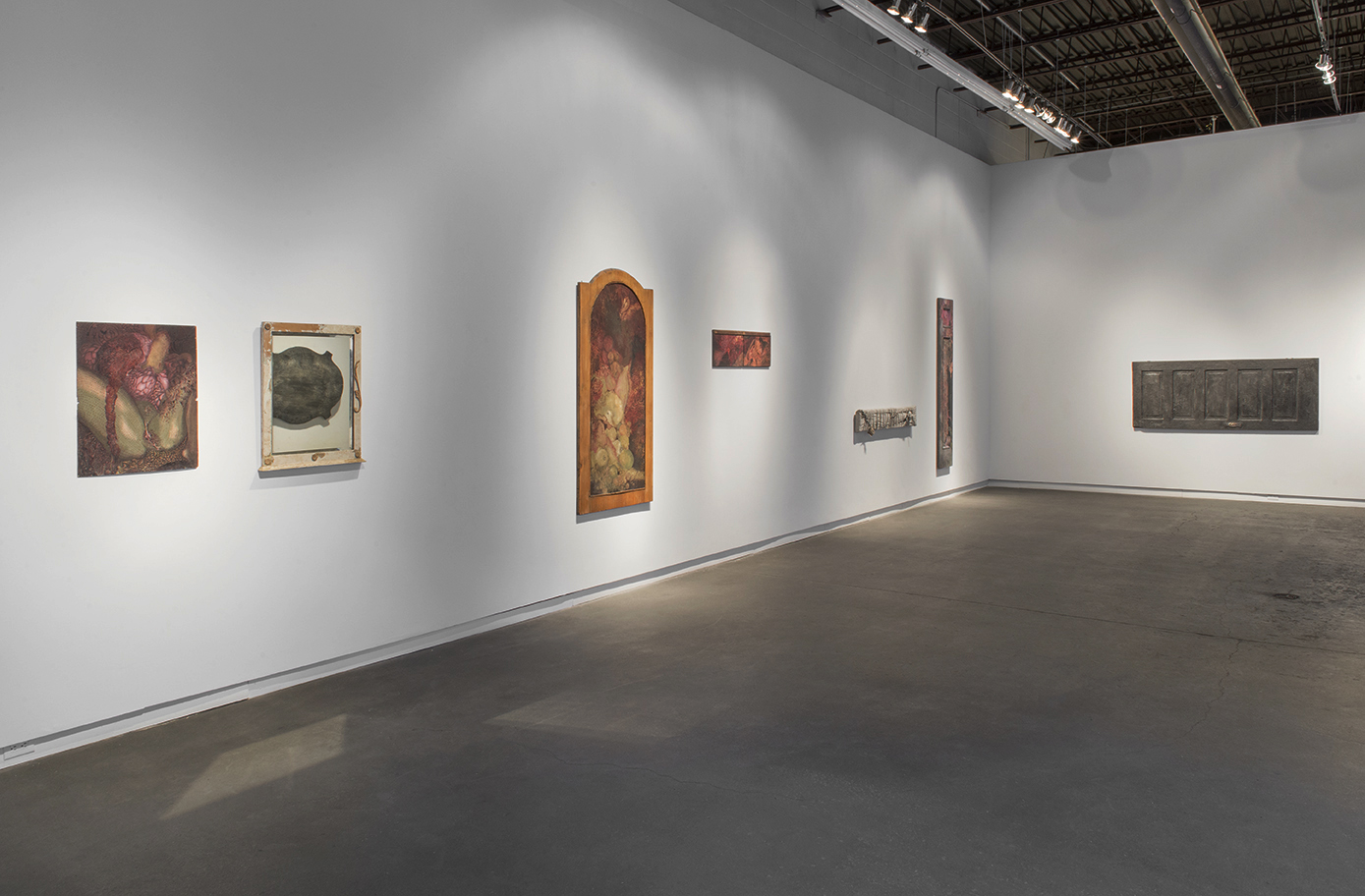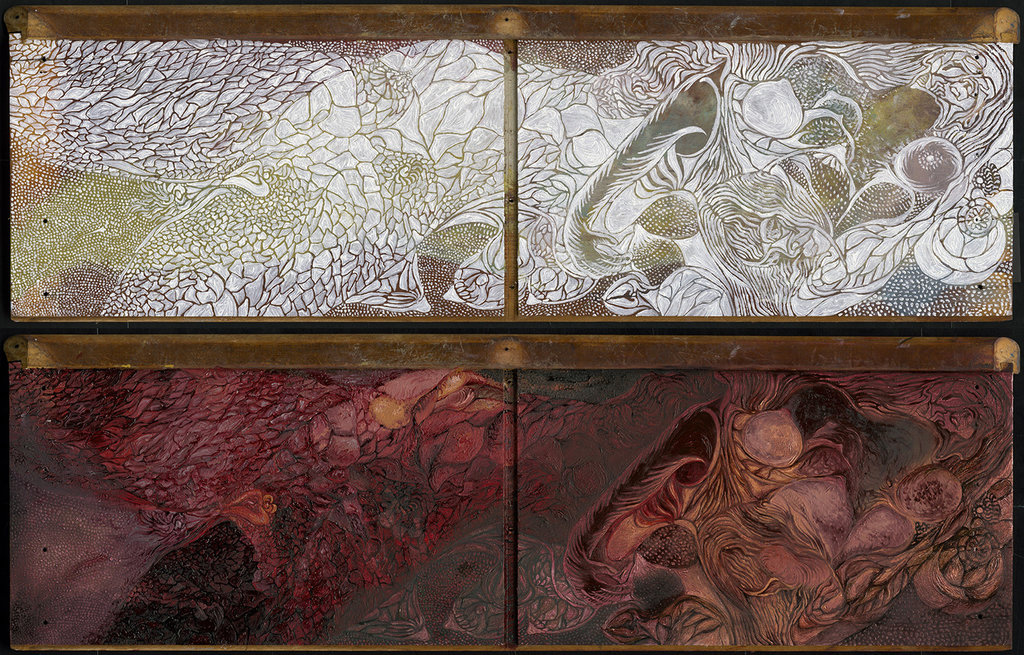 Installation view of Iris Häussler: The Sophie La Rosière Project – Chapter III, at Daniel Faria Gallery, 2017. Courtesy of Daniel Faria Gallery
Installation view of Iris Häussler: The Sophie La Rosière Project – Chapter III, at Daniel Faria Gallery, 2017. Courtesy of Daniel Faria Gallery
Secrecy and revelation are the dominant motifs of Iris Häussler’s Sophie La Rosière Project, an elaborate undertaking which presents a plethora of objects related to a fictional artist active in the late ninetieth – early twentieth century, including not only the paintings attributed to her creative efforts, but also the supposed articles from her workstation and living quarters, and even video installations where contemporary conservationists restore her artworks, critics place them within the Fin de siècle and modernist milieu, and psychoanalytics navigate members of the audience through crests and throughs of the artist’s tumultuous mental life. Sophie La Rosière’s preferred working surface was the rough wooden terrain of doors and shutters, later concealed by layers of black wax. Conceiving, producing and concealing La Rosière’s painting took the authorial mastery of Iris Häussler. To unveil and interpret the concealed, Häussler summoned outside parties, without, apparently, letting some of them in on the main secret behind the artifacts presented to them: fictionality of the artist that supposedly brought them to life.
 Iris Häussler, The Sophie La Rosière Project (SLR-262, 1912), 2016. Oil paint on wood. 12″ x 37”, fragment. Photo: Andriy Bilenkyy
Iris Häussler, The Sophie La Rosière Project (SLR-262, 1912), 2016. Oil paint on wood. 12″ x 37”, fragment. Photo: Andriy Bilenkyy
 Iris Häussler: The Sophie La Rosière Project – Chapter III. Courtesy of Daniel Faria Gallery
Iris Häussler: The Sophie La Rosière Project – Chapter III. Courtesy of Daniel Faria Gallery
Secrecy produces an “immense enlargement of life,” writes Georg Simmel, a German sociologist, philosopher, and critic most active at the beginning of the twentieth century, contemporaneously with the supposed heyday of La Rosière’s artistic career. “The secret,” Simmel notes, “offers, so to speak, the possibility of a second world alongside the manifest word: and the latter is decisively influenced by the former” (Soziologie, 1908). At the heart of secrecy, according to Simmel, lies a conflict between concealment and revelation, an external one, between the holder and the outsider, and, sometimes, an internal one, between the holder’s desire to keep something secret and her conflicting desire to divulge it. Finctionality, as always, complicates things; in case of Sophie La Rosière Project, the conflict is between the character’s desire for privacy and the author’s interest in showcasing her creation.
 Installation view of Iris Häussler: The Sophie La Rosière Project – Chapter III, at Daniel Faria Gallery, 2017. Courtesy of Daniel Faria Gallery
Installation view of Iris Häussler: The Sophie La Rosière Project – Chapter III, at Daniel Faria Gallery, 2017. Courtesy of Daniel Faria Gallery
 Installation view of Iris Häussler: The Sophie La Rosière Project – Chapter III, at Daniel Faria Gallery, 2017. Courtesy of Daniel Faria Gallery
Installation view of Iris Häussler: The Sophie La Rosière Project – Chapter III, at Daniel Faria Gallery, 2017. Courtesy of Daniel Faria Gallery
 Installation view of Iris Häussler: The Sophie La Rosière Project – Chapter III, at Daniel Faria Gallery, 2017. Courtesy of Daniel Faria Gallery
Installation view of Iris Häussler: The Sophie La Rosière Project – Chapter III, at Daniel Faria Gallery, 2017. Courtesy of Daniel Faria Gallery
In Chapters I and II of the Project, presented earlier at The Art Gallery of York University and Scrap Metal Gallery, this conflict reached an uneasy stalemate, as Häussler took care not to extract La Rosière’s paintings completely from their supposed original environment. In Chapter III, showcased at the Daniel Faria Gallery, the author clearly prevails. The exhibition is an overview of the key elements of the Sophie La Rosière Project, not a presentation of La Rosière’s oeuvre; it’s a celebration of the author rather than an homage to her fictional character. The difference is subtle but noticeable. As one walks through the spacious premises of the gallery, looking at wax-covered doors, x-rays of what they once concealed, restored works and sketches – all arranged matter-of-factly, as works of a contemporary artist, without the meticulously constructed vintage ambiance of a recluse’s workstation or the austerity of a conservationist’s workshop, one can’t shake the impression that the author has triumphed over her creation, and that it wasn’t an easy victory. “The intention of hiding,” notes Simmel, “takes on a much greater intensity when it clashes with the intention of revealing.” Here, “the intention of revealing,” has won the day. All the secrets are uncovered. Iris Häussler is ready to move on.
Andriy Bilenkyy
*Exhibition information: March 9 – April 29, 2017, Daniel Faria Gallery, 188 St. Helen’s Avenue, Toronto. Gallery Hours: Tue – Fri, 11 – 6; Sat, 10 – 6 pm.
